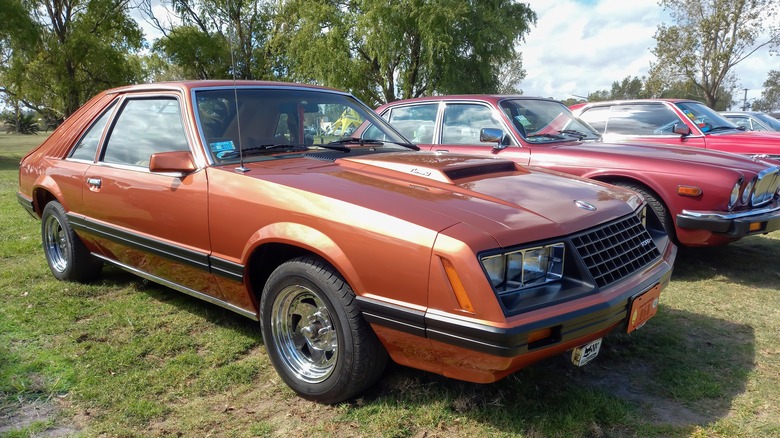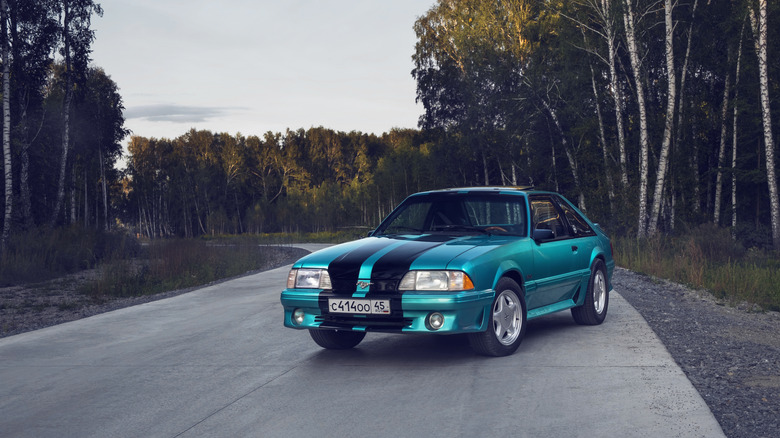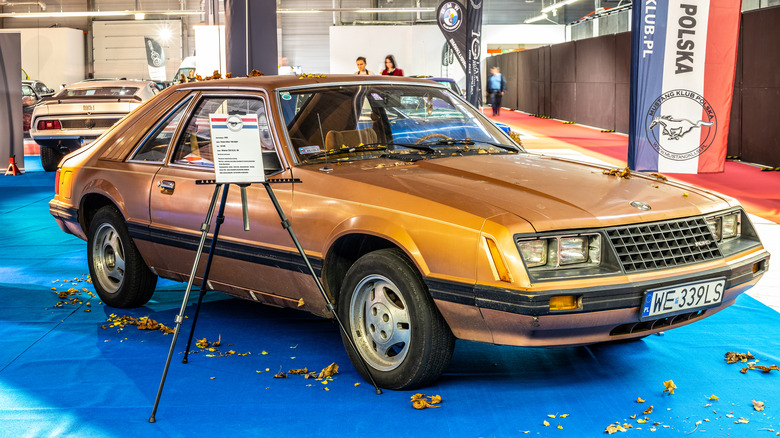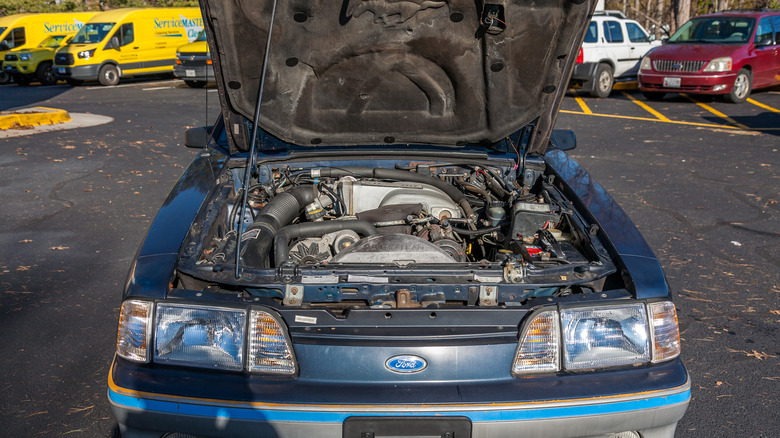5 Reasons You Should Own A Foxbody Mustang In 2023
The 1979 Ford Mustang has become a classic reimagination of the iconic car. Drawn up by Jack Telnack, the vice president of design for Ford Europe, the third generation of the legendary pony utilized a smaller, European-style body. A part of this history goes even deeper than just the Mustang heritage, however, and the change in design flows directly from it.
After the oil crisis that gripped the nation in 1973, Ford and many other automakers looked to reduce their products' cumbersome and gas-guzzling size. The industry estimated this would put consumers at ease if further gasoline price spikes and scarcity were to return to the market. To chase after this goal, Ford came up with the Fox body. It was a scaled-down chassis that weighed less and sported a wider engine bay than its predecessor (the Falcon platform).
The original '79 Foxbody Mustang came with several different engine options, including a prized 5.0L V8 with 140 horsepower. The stock '80s models would do away with high-performance engines as standard inclusions while retaining four-speed manual or three-speed automatic transmission options. However, special packages housed these upgrades. This era's Mustangs entered service as police cars, complete with a workhorse 5.0L engine. Mustangs of this period were in high demand, and they remain a popular choice for car collectors today. Here are five reasons to add one to your collection.
Foxbody Mustangs offer a nostalgia overload
The Foxbody Mustang was the iconic '80s racer. The third generation of the Mustang was produced between 1979 and 1993 and dominated an entire decade with its iconic styling. Not only that, these Mustangs were the longest-running model type in the car's history, making them arguably the epitome of what a Mustang is. The Mustang III also lifted the second-generation model out of middling obscurity. The previous iteration was underpowered and generally un-loved by the auto community. Since then, Mustangs have enjoyed wild success in pop culture and as a feather in the cap of Ford's sales statistics.
Because of the car's iconic status, it's easily one of the most nostalgia-inducing models an avid car collector can find. There's something special about the edgy lines and angles contours of the vehicle that mesh perfectly with the feelings of sentimentality that a lover of the '80s will take from the car. Foxbody Mustangs embody the decade like no other cars can.
Foxbodies are street racing legends
Foxbody Mustangs has seen their fair share of the track. Drag races and sanctioned street events have been well-trodden stomping grounds for Foxbody Mustangs, and these older models are turning heads on racing strips today. In 2022, a classic Foxbody went head to head against a Turbo S197 (the eventual winner) in the first round of the competition at TX2K 2022. The trusty Foxbody was beaten by just under one-tenth of a second but spent the first stretch of the track up on two wheels after a rapid start off the line.
Perhaps adding to their mystique, Ford and Chevy have remained in a pitted battle for muscle car supremacy on American roads for decades. While both platforms would have been a common sight on an '80s drag racing strip, the Foxbodies maintained the upper hand throughout Ford's production run.
Foxbody Mustangs have always been the envy of racers because of the varied engine capabilities, the light framework underlying the car itself, and the classic silhouette that the vehicle cuts as it barrels down the track. These Mustangs made their way into the world of professional racing and competed in international events in Australia and Europe. Most notable for many, however, is the selection of the 1979 Mustang as the official pace car for the Indianapolis 500.
The Foxbody is light on its feet and affordable
The Foxbody Mustang's scaled-down chassis platform makes the car lighter than previous models. These Mustangs are high-performance automotive options for racers and daily drivers alike. The third-generation Mustang was the first to use MacPherson-designed front suspension. This inclusion made cornering and general handling more stable, allowing drivers to maintain better control over their vehicle than was previously typical for Mustangs.
Foxbodies could also be found with convertible tops, making them an excellent option for lighthearted driving during the warm weather months. The handling and zip that a Foxbody Mustang brings make them a satisfying vehicle to own and drive, and many Foxbody Mustang owners swear by the ride. In the 14 years that Ford built these unique Mustangs, the company sold more than 2.6 million, meaning the market is completely saturated with Foxbody models of all sorts. The median price of a Mustang from this era in fair condition is $9,300, with better examples fetching a price slightly more than double that figure.
Aftermarket parts can be found in huge abundance
In addition to its potent driving attributes, the Ford Mustangs produced during this era were some of the most modified cars ever. Performance enhancements were nearly a standard part of ownership for the Mustang III, and aftermarket parts were produced so routinely that they can still be found virtually without trouble today. This makes the Foxbody Mustang a customizable option for racing enthusiasts or car owners looking for other personalities.
Aftermarket support is a big concern for many vintage car owners. A broken mirror, busted gasket, or scratched door handle can lead to a wild goose chase that ends in weeks or months of searching simply to come up empty. The Foxbody Mustang certainly doesn't suffer from this kind of scarcity, so fixing a problem in the car or installing new performance components to bring the vehicle up to muster for race day is easy and often affordable. Body kits are also an owner's favorite. Enhancing the ride's visual appeal with customized upgrades can take an already iconic ride to an entirely new level.
These models can fetch a significant resale value
While the average Foxbody Mustang is reasonably priced, this doesn't mean they don't make great investments. Foxbody Mustangs have been widely used in racing circles, and stock models have become true collector's items. These vehicles aren't vintage like a '60s era racer might be but remain part of the classics catalog. This means that purchasing one that needs some TLC can be done without a sky-high price tag, but a finished restoration can also attract a serious cadre of buyers and ramp up the price. Restoring vintage Mustangs from this era can be a game changer for those already in the business of classic car care.
With the wide range of special edition models, factory-customized options, and Saleen variants, there's much to get excited about in the market for older ponies. You could even score a police interceptor model that brings a unique vibe to the garage. Whether you're looking for a quick turnaround opportunity to score some profit or a longer-term investment, Foxbody Mustangs offer themselves an excellent option for collectors thinking of the bills and the engine performance, vehicle aesthetics, and handling abilities.





